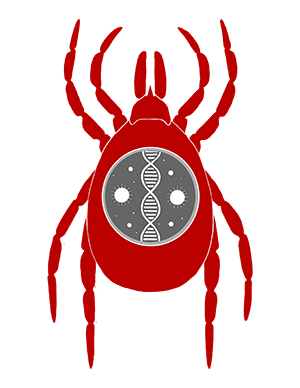What we do
Ticks can transmit germs (i.e., pathogens) to people, pets, or livestock. Since we care about the health of your WHOLE family, we include germs that cause disease in humans and animals in our standard panels for one flat rate of $49.99 per tick. We will identify which species of tick(s) you have submitted and then run the panel(s) for the most common disease-causing germs that species is known to transmit. See a list of our panels below.
Each test includes internal quality controls that indicate whether the DNA we extracted from your tick(s) is of sufficient quality for testing. If your specimen turns out not to be a tick during identification or if the DNA fails our quality controls during testing then you will receive a refund. Read our refund policy here. Our tests also include positive and negative controls for each pathogen that ensure our tests ran properly. Together, this suite of controls gives us the utmost confidence that we are providing you with the highest quality results. The results report will contain a picture of the front/back of the tick you submitted and the test results that will indicate whether the tick sample tested positive or negative for the pathogens specific to the tick species. See a sample report here.
The Buckeye Tick Test does not provide medical advice and tick testing should not be a substitute for consultation with your healthcare provider or veterinarian, however it can be very useful information to share with them. Learn more about what tick testing can and cannot tell you below.

What tick testing can tell you:
Submitting ticks for identification and testing is useful for risk assessment:
- Knowing what ticks and tick-borne germs are found in areas that you frequently enjoy is valuable to understanding the general risk to you and your pets from local ticks. The risk of tick-borne germs varies by location and studies show that most people (and therefore pets) encounter ticks during routine activities close to home so knowing what occurs in areas you frequent is especially important.
- Knowing what type of tick bit you or your pet and what germs it harbored can inform your risk of infection and potential for tick-borne disease. This is valuable because different ticks transmit different germs, diagnosing tick-borne germs in people and pets can be tricky, and many tick-borne diseases present with similar symptoms so tick identification and testing can help your healthcare provider with differential diagnosis. It may also inform treatment options and risk of co-transmission of more than one tick-borne germ.
- Knowing what ticks and tick-borne germs are found in Ohio and beyond is helpful for tracking the spread of ticks and tick-borne germs to educate our medical and veterinary communities of local risks. The distribution of ticks is rapidly expanding in the U.S., especially in the Ohio River Valley, resulting in increasing cases of tick-borne disease in areas where there used to be little risk. Surveillance therefore contributes to awareness and timely diagnosis, so we aggregate and anonymize our data from your submissions to share it with the Ohio Department of Health and the CDC.
What tick testing cannot tell you:
- Whether or not you or your pet have been infected with a tick-borne germ and will become ill. Transmission of germs from ticks is a complicated process so even when a tick is infected, you or your pet may not become infected after being bitten. Also, some people or pets can be exposed to tick-borne germs but do not experience clinical illness.
- Whether or not you or your pet were bitten by another tick. It is possible that not all ticks were noticed so it is important to be diligent about monitoring you or your pet’s health following a tick bite regardless of these test results.
- Whether or not the tick you submitted is infected with other tick-borne germs that are not included on our tests. Our panels include the most commonly reported tick-borne germs, however there is always a possibility of infection with rare or even novel germs. Again, it is important to be diligent about monitoring you or your pet’s health following a tick bite regardless of these test results.
 Buckeye Tick Test
Buckeye Tick Test